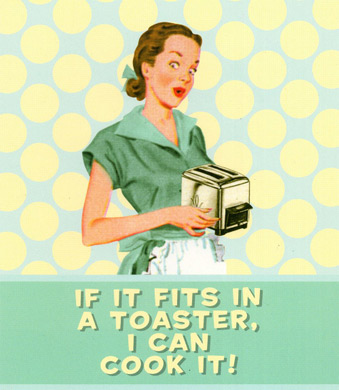A kind of consideration of toast.
Publishers have found a ready market for books that address a single item of food; cod, oysters, salt and an entire line of titles in “The Edible Series” from Reaktion Books that ranges from Cake and Caviar to Pizza and Whisky. Bee Wilson, the Daily Telegraph food columnist, has contributed Sandwich: A Global History to the series.
A recent addition to the dubious canon is Toast: The Cookbook by Raquel Pelzel (London 2015). “Toast,” the endpaper trumpets, “is the ultimate canvas for culinary creativity in your home kitchen--an exploration of flavor and seasonality, with something for every palette [sic] and occasion.” The claim is of course ridiculous, and so is the unnecessary warning to “[r]emember that the better the bread, the better the toast,” (Pelzel 7) which arouses suspicion that this thin volume required padding to reach even its modest length.
Other portents include the arbitrary grouping of the recipes by season: There is really nothing seasonal about a hanger steak or head of cauliflower. The inclusion of “guest chef” recipes provided by celebrities raises further doubt, and so does the limitation of precisely fifty recipes to precisely one page apiece along with the full page photograph that accompanies each one. All of this should indicate that the author or her editor knows the audience for Toast has little culinary knowledge or desire actually to cook anything, likes picture books more than text and suffers from the shortest attention span.
that accompanies each one. All of this should indicate that the author or her editor knows the audience for Toast has little culinary knowledge or desire actually to cook anything, likes picture books more than text and suffers from the shortest attention span.
To attract millennial attention, the style is breezy with the false informality the cohort appears to require. Pureed fava beans become ‘fava smash,’ British people are ‘Brits’ and one recipe boasts a ‘South Indian vibe.’ Not necessarily a style for the ages but then sales are sales.
Toast, in other words, is very much a child of its tweet ridden time. It therefore would be an understandable mistake to consign the book to the trash heap where so much contemporary writing about food belongs. Pelzel has provided a number of creative recipes of considerable appeal, and even the celebrity chefs have come through with contributions even if some of them, for instance Fergus Henderson’s excellent Scottish mince, which appeared earlier in his Beyond Nose to Tail, a kind of British cooking: Part II, have no traditional connection to toast (Henderson serves it with potatoes).
Pelzel’s own ‘Bombay Bubble and Squeak Toast’ smears the traditional cooked (often leftover but no less appealing for that) cabbage, potato and random vegetable fry-up spiked with curry and cilantro over a film of chutney on thick white toast. Hugh Acheson, whose own cookbook from the American south should be required reading, puts together little turnips and their greens with chicken poached in stock, onion and celery. The requisite toast is coated with apple butter before the chicken and turnip stew gets a sprinkle of broken almonds and farmer cheese.
It has become obligatory to genuflect before the Middle Eastern imagination in play at Honey & Co. in London, so Toast includes a composition of spiced chicken liver with caramelized onion and hard boiled egg from its proprietors, proving that in their case fashion is no impediment to quality.
As the examples cited indicate, inspiration for the recipes is as global as the history Wilson has purported to write, and for the most part will not disappoint the diner otherwise jaded by the proliferation of clumsy attempts at fusion or hybrid dishes. So forgive its flaws and give Toast a chance.

